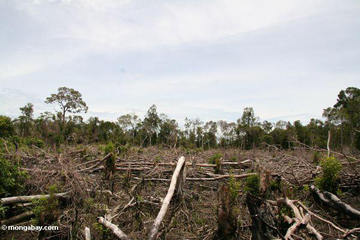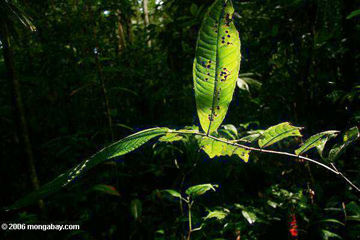How private equity can profit from carbon offsets in Indonesia
How private equity can profit from carbon offsets in Indonesia
Rhett Butler, mongabay.com editorial
August 29, 2007
|
|
The emerging carbon market for avoided deforestation presents unprecedented opportunities for private equity to make profitable investments that also help protect the environment. Indeed, for the first time, conservation may be associated with positive financial returns. Here’s a brief look at how private equity and other investors can capitalize on this opportunity to earn attractive returns while fighting climate change, protecting ecosystem services, and safeguarding endangered species like orangutans.
Avoided deforestation is the process by which landholders sell the carbon rights to a given area to private investors. The private investor then sells the carbon credits on international markets to companies looking to offset their emissions. Avoided deforestation is currently only recognized as a voluntary emission reduction (VER) scheme, but it is expected that the concept will be embraced at the December U.N. climate (COP-13) meetings in Bali, especially if proof-of-concept projects are showing signs of success.
Indonesia, thanks to its nearly 20 million hectares of peatland swamps, is well-positioned as a source of avoided deforestation offsets. In fact, conversion, draining, and burning of these peatlands is presently estimated by Wetlands International, an NGO, to release some 2 billion tons of carbon into the atmosphere each year. This equates to 8 percent of human global carbon emissions and is why Indonesia is the world’s third largest emitter of carbon after China and the US.
 Forest clearing in Kalimantan (Indonesian Borneo). Rhett A. Butler |
In recent months, Investors — ranging from wealthy individuals to banks, hedge funds, and forestry companies — have been evaluating the potential of such credits in Indonesia but have thus far been hesitant to make deals before a binding framework is in place. Nevertheless, a ripe opportunity exists.
Financial analysts would be smart to start looking at the debt of firms that own or control rights to large tracts of undisturbed forest land in Indonesia: pulp and paper companies, mining corporations, agribusiness, and plantation firms. While commodity prices are high, there still may be bargain opportunities given the structure of loans and recent worries in the credit markets. For example, an eight-year study by the nonprofit Center for International Forestry Research (CIFOR) suggests that some companies, especially pulp and paper operatives, may have overstated their financial health by exaggerating the extent and availability of pulpwood. CIFOR’s report reveals that, in some cases, financial institutions conduct only minimal due diligence to assess the sources of wood for pulp projects, with banks relying heavily on data provided by the pulp producers themselves. CIFOR says the lack of due diligence significantly increases financial risk of some projects. CIFOR specifically cites two companies in Indonesia, Asia Pulp & Paper (APP) and Asia Pacific Resources International Ltd. (APRIL), as examples where “financial institutions failed to conduct proper due diligence on fiber supply.”
 Old-growth tropical rainforest. Rhett A. Butler |
“During the 1990s, APP and APRIL borrowed over US$ 15 billion from international capital markets by telling investors that they have sustainable supplies of very low-cost fiber. However, both companies continue to rely on the clearing of natural forests in Sumatra for 60-70% of their wood supply, and each is still years away from meeting its own plantation development targets,” said Christopher Barr, CIFOR senior scientist and coordinator of the study.
Analysts should closely examine the finances of such companies, looking for distressed debt situations that could lead to large land acquisitions on the cheap. Upon acquiring such a company, its pulping and forestry equipment could be sold to provide cash to help finance the acquisition. The financial firm could then make arrangements to sell the carbon credits in international markets while at the same time earning marketing points and goodwill among its investors and customers.
The income from the acquisition wouldn’t have to be limited to fixed carbon credits. The financial firm could hire local companies (providing local employment) to plant deforested and degraded areas in the concession. In so doing, the firm may be able to collect additional carbon credits for reforestation or use the newly forested land for timber plantations or agriculture. Because the land is reforested, its use would not result in net emissions.
Under the scheme, natural forests would be protected for their carbon value as well as their resident biodiversity and the other ecosystem services they afford. Not only might these ecosystem services result in payments for landowners in the future, but the presence of biodiversity — think orangutans, gibbons, and hornbills — may allow the firm to further diversify its income through ecotourism. The firm could establish a relationship with a tour operator to develop nature-oriented tourism that provides additional employment for locals. The social and environmental return from such an investment strategy could be immense relative to typical extractive industries. It could also be profitable.
References
- CIFOR (2006). Financing Pulp Mills: An Appraisal of Risk Assessment and Safeguard Procedures [1 MB PDF]
- Mongabay.com (2007). Is peat swamp worth more than palm oil plantations?
- Mongabay.com (2007). Could peatlands conservation be more profitable than palm oil?
- Mongabay.com (2006). Reducing tropical deforestation will help fight global warming
- Mongabay.com (2006). Why is oil palm replacing tropical rainforests
- Mongabay.com (2006). What do bikini models and banks have to do with deforestation?